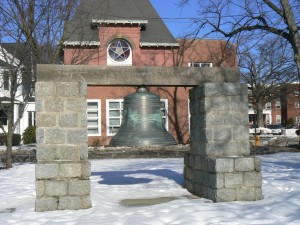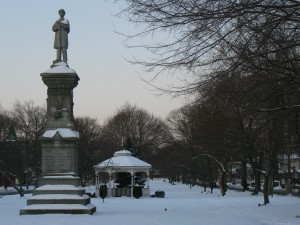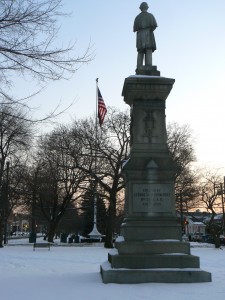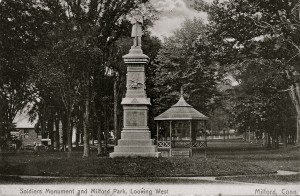 We continue our look at downtown Milford monuments by examining the World War II monument at the east end of the Milford Green. The monument commemorates the local residents who served in the war, with five statues representing the contributions of local soldiers, seamen, airmen and nurses.
We continue our look at downtown Milford monuments by examining the World War II monument at the east end of the Milford Green. The monument commemorates the local residents who served in the war, with five statues representing the contributions of local soldiers, seamen, airmen and nurses.
The nearby memorial flagpole (mentioned in our post on the Soldiers’ and Sailors’ monument) near the center of the green lists the names of 78 residents who died in the war.
Immediately west of the World War II monument is a monument dedicated to the firefighters who have been protecting Milford since the first company was founded in 1838. A bell, which summoned volunteer firefighters to Milford’s central firehouse between 1887 and the 1930s, sits mounted next to a granite marker that explains its history. The other side of the granite marker lists the names of six local firefighters who gave their lives in the line of duty.
Tags: Firefighters, Milford
This week, we look at several monuments on (or near) the green at the heart of downtown Milford, which was founded in 1639. We’ll start with the Soldiers’ and Sailors’ Monument, which was dedicated in 1888 to commemorate local residents who served in the Civil War.
The four sides of the monument beneath the soldier lists battle locations of Gettysburg, Fort Fisher (North Carolina), Port Hudson (Louisiana) and Appomattox, and also feature several symbolic icons.
A flower bed at the base of the monument helps to discourage active interaction with the monument during warmer weather.
The flagpole in the background of the image facing away from the monument was built in 1954, and is dedicated to the citizens of Milford who have lost their lives in World War II, Korea and Vietnam (monuments honoring those wars will be featured later this week). Its 15-sided base includes 13 stone markers listing the names of 93 local residents killed in those conflicts.
As you can see from the vintage postcard below, a gazebo has long stood near the monument. The card’s postmark is unclear, but the back is divided, so it was printed after 1907. If you look in the lower left corner (enlarged in the next image), you’ll see a horse-drawn delivery carriage.
In front of the monument is a memorial fountain erected by the Ford family to honor their ancestor Thomas Ford, one of Milford’s founders. The fountain is used today as a planter.
Sources:
Connecticut Historical Society: Civil War Monuments in Connecticut
Milford, Connecticut, 350th Anniversary Book (1639-1964)
History of Milford Connecticut 1639-1939, Federal Writers’ Project, 1939 (1973 reprint by the Milford Historical Society)
Tags: Milford
 The Defenders’ Monument, located at the intersection where Columbus and Davenport avenues meet Ella Grasso Boulevard (Route 10) in New Haven, commemorates the more than 150 local militia and students who combined to harass British troops who invaded the city on July 5, 1779.
The Defenders’ Monument, located at the intersection where Columbus and Davenport avenues meet Ella Grasso Boulevard (Route 10) in New Haven, commemorates the more than 150 local militia and students who combined to harass British troops who invaded the city on July 5, 1779.
During the invasion, British troops attempting to capture a powder mill in the city’s Westville section were repulsed by New Haven residents and militia, including forces from nearby towns. The troops eventually began looting nearby homes and businesses, and spent the night on the New Haven green. The next morning, the troops returned to their ships (burning several warehouses near the harbor along the way) and sailed to Fairfield on July 7.
During the attack, 27 residents were killed.
The monument was dedicated in 1910, and depicts the combined efforts of local militia, residents and students in defending the city. As you can see from a vintage postcard (with a 1913 postmark), the gentleman on the left (as you face the monument) used to carry a ramrod that has been lost to vandalism or theft over the years. Now he’s primarily lending moral support. Also, the monument has been fenced in, perhaps in response to the ramrod disappearance.
Artist and sculptor James E. Kelly was also responsible for at least a dozen historic monuments, including the statues of John Buford in Gettysburg, George Washington at New York’s Federal Hall and the Monmouth Battle Monument in New Jersey.
The monument sits at the base of a small park that’s flanked by two cemeteries (St. Bernard’s to the south and Evergreen to the north). Both include Civil War monuments that will be featured in a future entry.
Update: The British troop landing site at West Haven’s Bradley Point is commemorated with a plaque on a small boulder.
Sources:
-Vision in the Sky, New Haven’s Early Years 1638-1783. Myrna Kagan, Linnet Books, 1989.
-Burpee’s the Story of Connecticut, Charles W, Burpee, American Historical Company, Inc., 1939
Tags: New Haven













